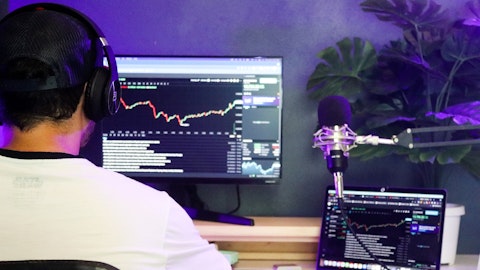Vornado Realty Trust (NYSE:VNO) Q4 2023 Earnings Call Transcript February 13, 2024
Vornado Realty Trust isn’t one of the 30 most popular stocks among hedge funds at the end of the third quarter (see the details here).
Operator: Good morning and welcome to the Vornado Realty Trust Fourth Quarter 2023 Earnings Call. My name is Andrea and I will be your operator for today’s call. This call is being recorded for replay purposes. [Operator Instructions] I will now turn the call over to Mr. Steve Borenstein, Senior President and Corporate Counsel. Please go ahead.
Steve Borenstein: Welcome to Vornado Realty Trust fourth quarter earnings call. Yesterday afternoon, we issued our fourth quarter earnings release and filed our annual report on Form 10-K with the Securities and Exchange Commission. These documents as well as our supplemental financial information packages are available on our website, www.vno.com, under the Investor Relations section. In these documents and during today’s call, we will discuss certain non-GAAP financial measures. Reconciliations of these measures to the most directly comparable GAAP measures are included in our earnings release, Form 10-K and financial supplement. Please be aware that statements made during this call may be deemed forward-looking statements and actual results can differ materially from these statements due to a variety of risks, uncertainties and other factors.
Please refer to our filings with the Securities and Exchange Commission, including our annual report on Form 10-K for the year ended December 31, 2023, for more information regarding these risks and uncertainties. The call may include time-sensitive information that may be accurate only as of today’s date. The company does not undertake a duty to update any forward-looking statements. On the call today from management for our opening comments are Steven Roth, Chairman and Chief Executive Officer; and Michael Franco, President and Chief Financial Officer. Our senior team is also present and available for questions. I will now turn the call over to Stephen Roth.
Steven Roth: Thank you, Steve and good morning, everyone. We ended the year on a high note with a good fourth quarter. The quarter and the year were right on target. Although as expected, our results were negatively affected by the dramatic increase in interest rates. This will carry through next year but I expect will reverse as interest rates receive. It’s important to note that our business has continued to perform well. Michael will review the quarter and the year with you in a moment. This year, our New York City office leasing team won the gold medal. In the fourth quarter, we leased 840,000 square feet. For the full year, we leased 2.1 million square feet. Average bidding rents for the quarter and the year were record-breaking at $100 and $99 per square foot, respectively.
In more gold medal stuff for the year, we leased 1.2 million square feet at over $100 a square foot rents. The office leasing market is on the foothills of recovery but the capital markets still remain challenged and are even tightening — and even tightening slightly as we speak. Foreclosures and givebacks are still in front of us and therefore, so is the opportunity. As Michael and I have said on the last few calls, retail in New York City has bottomed and is recovering rapidly. While rents have a way to go to reach peak pricing of 5 years ago, we feel very good about the activity level and strength of the retail recovery. And there’s more big retail news. In 2 blockbuster deals announced in December, major global luxury retailer’s product at time block front Upper Fifth Avenue properties for their own use as stores.
One deal was $835 million and the other was $963 million. So in round numbers, call it about $900 million for a half block front on Upper Fifth Avenue. So we now have the most important retailers in the world investing aggressively in real estate for their own use on the most important retail street in our country. This is only happening in the most important world cities, New York, London, Paris. Now we take this mark very personally because we own in our retail joint venture, so 52% on our share, a 26% market share of available Upper Fifth Avenue in 4 blocks — half block — 4 half blocks of similar AAA quality. I’m sure you can all do the math here. We also own in that same joint venture, the 2 best full blocks. So that would be 4 half blocks in Times Square and we have the largest signed business in town.
It’s been a long ride and we announced just about completed construction of our renovation of the double block-wide PENN 2 and we are about 90% complete with the surrounding clauses. The huge positive in front of PENN 2, combined with the 33rd Street Promenade and the 33rd Street setback at ton [ph] have created an enormous open public space which I might say will be quite logistic. Directly core 7th Avenue [ph], the hotel PENN is now down to the ground, creating our PENN15 site. All this taken together is for sure a game trader. If you are a shareholder of Vornado or are interested in Vornado, this is an immediate must go see. The world turns in funny ways that creates opportunity. The Apocalypse is now passing, having handily survived the e-commerce attack.
But now we have a CBD office Apocalypse involving the work from home threat and the total black listing of office in the capital markets. In the end, the major cities of America will continue to grow and thrive with New York, our hometown leading that. All these workers will gather in offices with their colleagues rather than be alone at home at a kitchen table. And in the end, the supply-demand equation will come into balance and bring on a landlords market by a total cut-off of new supply. You can’t build anything in these frozen capital markets. and in New York, the evaporation or relevance of, say, 100 million square feet of old, obsolete, unrentable space. This cycle was not over yet. There remain challenges but for forward-looking investors, the time is now.

My colleagues and I at Vornado are optimistic and excited. Now over to Michael.
Michael Franco: Thank you, Steve and good morning, everyone. Though 2023 was a challenging year, our core of retail businesses proved to be resilient. Our overall New York business same-store cash NOI and was up a healthy 2.8% for the year and was up 2% in the fourth quarter compared to last year. Comparable FFO as adjusted was $2.61 per share for the year, down $0.54 from 2022 and largely due to increased interest expense which is in line with the expectations that we previously communicated. Fourth quarter comparable FFO as adjusted was $0.63 per share compared to $0.72 per share for last year’s fourth quarter, a decrease of $0.09. Overall, the core business was flat and the entire decrease in the quarter was driven by increased G&A and lower FFO from sold properties.
We have provided a quarter-over-quarter bridge in our earnings release and in our financial supplement. We recorded $73 million of noncash impairment charges during the fourth quarter, primarily related to joint venture assets that we intend to exit in the next few years. It should be noted that in accordance with NAREIT’s FFO definition, this impairment charge is not included in FFO. Now turning to 2024. While forecasting remains challenging in the current economic environment, we expect our 2024 comparable FFO to continue to be impacted by higher interest rates and be down from 2023 which already seems to be in the market. We project a roughly $0.30 impact from higher net interest expense due to extending hedges at higher rates on our variable debt.
Additionally, there will be a ding to earnings as we turn over certain spaces. Primarily at 1290 Avenue of the Americas, 770 Broadway and 280 Park Avenue. This is temporary as we have already leased up a good chunk of this space but the GAAP earnings in these leases won’t begin in 2024. We expect 2024 will represent the trough in our earnings and for earnings to increase meaningly with mayor [ph] as rates trend down and as income from the lease up of PENN and other vacancies clients. Now turning to the leasing markets. New York is clearly leading the leasing charge nationally as the city continues to experience strong employment growth. 2023 leasing in Manhattan ended on a strong note. And as we enter 2024, market conditions are more favorable in any year since the pandemic ensued in March 2020, providing support for the continued recovery in Class A office market.
The economy is healthy, most employers are back in the office at least 3 to 4 days per week. Competitive sublease space is tending and the market for higher-end space is tightening, fueled by a decline in the new development pipeline. Now that companies have greater clarity on their space needs, tenant demand is growing which is translating into more leasing transactions. With new supply of operating, tenants are increasingly focused on the highest quality redeveloped Class A buildings their PENN Station and Grand Central Station as they seek to attract and retain talent. Activity in the best buildings has been strong with vacancy at less than 10% and rents rising. Our best-in-class portfolio has been a major beneficiary of this trend and the stats bear out this that we consistently outperform the marketplace, as Steve mentioned earlier.
In 2023, we leased 2.1 million square feet and average starting rents of the industry-leading $99 per square foot with 1.2 million feet at triple-digit starting rents. Importantly, we made significant strides in addressing our upcoming vacancy and tenant roll at some of our most important assets with leases with the following important customers. Citadel at 350 Park Avenue, PJT Partners and GIC at 280 Park Avenue, King & Spalding, so in game and Cushman & Wakefield at 1290 Avenue Americas and Shopify at 85 Tenth Avenue. Additionally, at PENN 1, we maintained strong momentum with another 300,000 square feet of deals, highlighted by new leases with Samsung and Cannacord Genuity. Just as a reminder, since we started our redevelopment efforts in the Penn District, we have leased over 2.5 million square feet of office at average starting rents of $94 per square foot, a significant increase on what these buildings achieved previously.
Our fourth quarter activity led the overall market’s leasing volume upturn as we completed 17 leases comprising 840,000 feet at starting rents of $100 per square foot. Even with our very strong close to 2023, our leasing pipeline heading into 2024 is robust. We currently have almost 300,000 feet of leases in negotiation with another 2 million feet in our pipeline at different stages of negotiation, including a balanced mix of new and renewal deals. Turning to the capital markets now. While the financing markets for office remain very challenging as banks continue to deal with problem loans, we are starting to see some stability with the Fed potentially cutting rates in 2024. Fixed income investors are constructive again on high-quality office and unsecured bond spreads for office have tightened significantly over the past couple of quarters.
That being said, we are still a way away from a healthy mortgage financing market in office. And most office loans will have to be restructured or extended as they aren’t refinanceable at their current levels. More broadly, lenders have no appetite for construction financing across most property types which should keep a lid on new supply. Conversely, the financing market for retail is now wide open now that the sector has bottomed. As always, we continue to remain focused on maintaining balance sheet strength. Even in this challenging financing environment, our balance sheet remains in very good shape with strong liquidity. We are actively working with our lenders and making good progress pushing out the maturities on our loans which mature this year.
Our current liquidity is a strong $3.2 billion and $1.3 billion of cash and restricted cash and $1.9 billion undrawn under a $2.5 billion revolving credit facilities. With that, I’ll turn it over to the operator for Q&A.
See also Top 15 Electric Bike Brands According to Reddit and 25 Most Spoken Second Languages in the World.
Q&A Session
Follow Vornado Realty Trust (NYSE:VNO)
Follow Vornado Realty Trust (NYSE:VNO)
Operator: [Operator Instructions] And our first question comes from Steve Sakwa of Evercore ISI.
Steve Sakwa: I guess first question for Michael or maybe Glen, just kind of on that, I guess, pipeline, the 2 million square feet that you talked about, could you maybe tell us a little bit how much of that is for kind of the existing portfolio, how much of that is for the development such as PENN 2 and in that discussion, can you just talk about the upcoming expirations in ’24? Are there any large known move-outs this year that you might know about that you could share with us?
Glen Weiss: Steve, it’s Glen. So of the pipeline that we mentioned in the opening remarks, there is a good spread in there, including PENN1 and PENN2. So activity continues to strengthen at both properties. The reception at PENN 2 has been better than excellent tour volume is off the charts. Everyone thinks this thing is, wow, nothing they’ve ever seen. So the pipeline does include activity at both PENN 2 and PENN 1. As it relates to the bulge in ’24 — the expirations that we were facing, we’ve attacked, I think, very well thus far, at 1290, we’ve already leased more than 50% of the space that was expiring in ’24 between better and equitable. At 280 Park, we released over 200,000 feet of the 275,000 feet expiring 24 and ’25 and put away PJT which was expiring in ’26.
770 Broadway, we continue to be in the market with that building, of course, is more of a big tech, big media building but we expect that building to perform as we move along here, given its great location and great bones.
Steve Sakwa: Just a quick follow-up. Are you saying 770, does that have a meta expiration that?
Glen Weiss: It does. It is a matter of expiration of 275,000 feet in June of this year.
Steven Roth: At risk, Meta [ph].
Glen Weiss: Yes. So, after that expiration, Steve, we’ll have another 500,000 feet long term in the building.
Steve Sakwa: Okay, great. And then just on the second question, I noticed that you pushed out the stabilization of PENN 2 by year which certainly makes sense just given the challenging market today but you, guys, also kept the — I guess you kept the yield unchanged. So just can you kind of help us think through that? And I guess, from an accounting perspective, if leasing doesn’t occur this year somewhat soon. Does that begin to create a potential earnings drag in ’25 just from the lack of ability to continue to capitalize costs on that project.
Michael Franco: Steve, it’s Michael. The answer with respect to stabilization is that we did push it out to ’26. It’s taken a little longer to get going on take-up there. But as Glen just referenced the reaction as it’s gotten to delivery here has been outstanding. So we expect that to pick up. But that being said, we’re trying to be realistic as well and so we pushed it out. The yield is based on the $750 million [ph] cost does not include carry. So that’s based NOI of the original cost. So that’s a simple math for you. Trade [ph] drag beyond ’25. If it’s not done, I guess, potentially but we feel good about the pipeline and what we have baked in right now.
Operator: The next question comes from Michael Griffin of Citi.
Michael Griffin: Steve, I know in your opening remarks, you talked about the stressed opportunities you’re seeing out there in the market. Can you maybe quantify kind of what those opportunities could be? And when you look at kind of capital allocation priorities, would it make sense to take advantage of those maybe relative to buying back your stock or starting new developments?
Steven Roth: There are 3 opportunities, buying back our stock is the first one or usage of capital allocation. The second is paying off debt and deleveraging a little bit. And the third is offensively acquiring new assets. We are only interested in acquiring new assets at distressed prices. And I think as I’ve said, the foreclosures and the givebacks have not really has accelerated was the opportunities are still in front of us. I don’t have any comments as to what we might do. But I think our number one priority is the debt that we need to — the debt expiries. And then after that, we go on the assets. The stock, we will react opportunistically to the stock price over time.
Michael Griffin: Great. And then, I was wondering if you could comment on the recent news about a rent reduction from a tenant at 650 Madison. I know you only own 20% of this building but is there a worry that we should extrapolate this in terms of kind of future rent roll and maybe a sign of things to come from a leasing and rent perspective?
Steven Roth: The interesting thing is some of the industry papers they always get it right. But in this case, they got dead row [ph]. The facts are that the $60 number was a net number. So if you gross it up, it’s about $100 a foot. It’s telling me it’s a little less than $100 a foot but — so it’s in the low $90s, I guess.
Operator: The next question comes from Camille Bonnel of Bank of America.
Camille Bonnel: Can you talk a bit more to the retention levels of the overall portfolio in 2023? How did it track versus your expectations? And with the lack of new supply on the horizon, do you think this will pick up in ’24?
Glen Weiss: It’s Glen. Our retention rate was strong. As I mentioned, the leasing that we’ve gotten done, the renewals that thing went better than we originally had thought the beginning of ’23. And in our pipeline that we referenced, we have very good activity on forward lease expirations, we’re definitely finding that CEOs, the decision makers of these tenants were expiring forward are now coming to us earlier than they have been over the past few years because there’s less and less quality blocks of space available to them. So I would say definitively, the renewal program is stronger than it had been. We’re in very good talks with many of our tenants going forward and I think it’s showing in our leasing activity numbers, especially with the volume we had during ’23 and what we’re now seeing in ’24 already.
Steven Roth: You make a good point. I think you said with the lack of supply. So the dynamics which are going to cause the office market to get very, very healthy, pretty soon, you can’t build anything in this capital market. So there will be no new supply coming on stream. The supply of buildings that were built in the last cycle over the last number of years, that base, it will be eaten up. And the next trend is that tenants seem to want high-quality buildings which are either brand new or buildings which have been completely retrofitted which is — and so the older buildings and I think I said the stock of those are somewhere around 100 million to 150 million square feet. Those are just absolutely an irrelevant and with a buffery [ph]. So what we’re dealing with is not 200 million — 400 million [ph] square foot marketplace we’re dealing with something which is somewhere in the high 200 million which is a totally different supply-demand equation.
Camille Bonnel: Appreciate the color bar. And given retail seems to be a bit of a bright spot in your portfolio, can you also talk about how your leasing pipeline is looking for that side of the business?
Michael Franco: Sure. I appreciate you recognizing the retail is a bright spot. I think it feels like investors wrote it off and with everything that’s happened in the marketplace forgotten that we still own the most and the highest quality retail in New York City, as Steve alluded to in his opening remarks. So these are scarce propria assets. I think the value is being recognized, we’ve talked about the last couple of quarters and it continues our leasing pipeline. We got activity across the board, really on all our spaces where there’s vacancy or rollover occurring we have tenant activity, in some cases, multiple tenants for those spaces. And rents are clearly rebounding. So I would just sort of say stay tuned. We’re optimistic in terms of what’s coming down the pipe based on what we’re working on right now.
Steven Roth: There is definitely a finite supply of the highest quality retail space which is what the marketplace wants. And then I hope you notice I have a new financial metric for retail which is called half block price. And we got a lot of half blocks in the best place.
Camille Bonnel: I appreciate that. And just finally, on the G&A side, you’ve managed to control those costs quite well since the pandemic but it did pick up last year due to some additional stock expense. Is this a reoccurring event going forward? And are there any key considerations for ’24 that will keep your G&A at the current or higher levels? Just for instance, less capitalized interest from your development program now that PENN 1 is out of the pool?
Michael Franco: No, capital will be comparable. G&A, some of that will roll off given that was a onetime event. But I think what you’re referencing generally is the compensation plans put in place which we felt important to retain our talent in a difficult environment. And so we implemented those one in June, heavily tied to entirely tied to stock performance over the next 3, 4 years. And the shareholders do quite well, then the employees will do quite well. So that expense was elevated in ’23. And that will start to, I think, normalize as we get into this year.
Steven Roth: How many years are we writing off the expense for the comp land? So it’s 4 years, you were accelerated. So say again, you were accelerated. So the expense we’re writing of the equity comp plan that we issued in June is over a 4-year period. So the G&A will benefit enormously shortly as that rolls off. And I think I said in my remarks, you climb the mountain and then you go to the other side of the mountain. So the rise in interest rates had penalized our earnings actually pretty substantially. That is going to reverse somewhere as the government begins to reduce which they will. And then similarly, well, I guess that’s the big — but those are the 2 — that’s the big thing. Now similarly, Michael said that our earnings were going to be hit or dinged, I think, was his word, by turnover independents from the bulls and expiry lease entry.
Once again, those spaces will fill up, income will come on board. So these are temporary reductions in our earnings which will absolutely reverse.
Operator: The next question comes from John Kim of BMO.
John Kim: Given all your commentary on street retail and how it’s recovered, the pricing has been very strong. Are you going to be looking to sell into this strength? Or do you think market rents are going to improve? Or is this really just telling us to update or not estimates?
Steven Roth: Hi, John. Well, the first thing is we’re enjoying the bounce back from the retail. I mean, retail has a target on its back threatened by e-commerce, et cetera. And that is all evaporated and now retailers become the vote. We believe that the asset prices of the assets that we own has decreased dramatically from the bottom. And we may take advantage of those prices by selling assets for year-to-year every once in a while. We’ve already sold a chunk of assets that we really thought were not part of our core. So we’ve sold some, we may well sell some more and we’re absolutely convinced that rents are going to rise where they rise to the peak pricing that they were 5 years ago? Probably not but they’re certainly going to rise from here.
John Kim: Okay. Do you think you’ll get the same pricing you got originally when you established that joint venture? In other words, pricing and assets reached a certain level.
Steven Roth: We’re delighted with the pricing that we were able to achieve in a large joint venture. We’re not going to speculate on what the pricing will be.
Michael Franco: John, it’s a speculation. I think if you look at the pricing that product in sharing paid. And Steve talked about the half blocks. And you analyze what our portfolio could be worth, then it’s not a stretch to say that we’re back at those levels or get back to those levels, right? Now and who knows over time. But I think what you’re seeing is, I think the most important thing is you have two of the most important retailers in the world who are saying Fifth Avenue is critically important to us. We want to be there forever. We are prepared to pay a meaningful price to be there. And I think the history of these things is the animal spirits get going. You don’t think that other retailers are behind them saying, maybe we need to make sure we have a place on fifth and secure our position. So I don’t think it’s a stretch to think that these aren’t the last two transactions that occur on fit.




